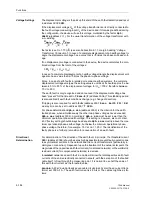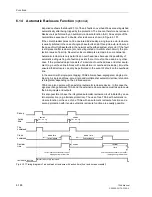
Functions
6-178
7SA6 Manual
C53000-G1176-C156-2
6.12
High-Current Switch-On-To-Fault Protection
6.12.1 Method of Operation
General
The high-current switch-on-to-fault protection is intended to trip immediately and in-
stantaneously following energization of a feeder onto a fault with large fault current
magnitude. It is primarily used as fast protection in the event of energizing the feeder
while the earth switch is closed, but can also be used every time the feeder is ener-
gized — in other words also following automatic reclosure — (selectable).
The energization of the feeder is reported to the protection by the circuit breaker state
recognition function. This is described in detail in Section 6.22.
Pick-up
The high-current pick-up function measures each phase current and compares it with
the set value
I>>>
(address
2404
). The currents are numerically filtered so that only
the fundamental frequency is evaluated. If the measured current is more than twice
the set value the protection automatically reverts to the unfiltered measured values,
thereby allowing extremely fast tripping. DC current components in the fault current
and in the CT secondary circuit following the switching off of large currents practically
have no influence on the high-current pick-up operation.
Figure 6-95 shows the logic diagram. The high-current switch-on-to-fault function can
be phase segregated or three-phase.
Following manual closure of the circuit breaker it always functions three-phase via the
release signal “
SOTF-O/C Release L123
”, which is derived from the central infor-
mation control in the device, assuming that the manual closure can be recognized
there (refer to Section 6.22).
If further criteria were determined during the configuration of the recognition of line en-
ergization (address
1134
Line Closure
, refer to Section 6.1.3) the release signal
“
SOTF-O/C Release Lx
” may be issued phase segregated. This only applies to de-
vices that can trip single-pole, and is then important in conjunction with single-pole au-
tomatic reclosure.
Tripping is always three-pole. The phase selectivity only applies to the pick-up in that
the overcurrent criterion is coupled with the circuit breaker pole that has been closed.
Figure 6-95
Logic diagram of the high current switch on to fault protection
SOF O/CpickupL3
4284
SOF O/CpickupL2
4283
SOTF-O/C Release L3
SOTF-O/C Release L2
L3
L2
L1
I
L3
I
L2
I
L1
I>>>
2·
√
2
·I>>>
≥
1
≥
1
SOTF-O/C Release L1
&
≥
1
2404
I>>>
SOF O/CpickupL1
SOTF-O/C Release L123
4282
SOF O/C Pickup
4281
SOF O/CtripL123
4295
Summary of Contents for siprotec 7SA6
Page 2: ...Siemens Aktiengesellschaft Book No C53000 G1176 C156 2 ...
Page 18: ...xviii 7SA6 Manual C53000 G1176 C156 2 ...
Page 32: ...Introduction 1 14 7SA6 Manual C53000 G1176 C156 2 ...
Page 82: ...Hardware and Connections 2 50 7SA6 Manual C53000 G1176 C156 2 ...
Page 119: ...SIPROTEC 4 Devices 4 25 7SA6 Manual C53000 G1176 C156 2 Figure 4 20 CFC Logic example ...
Page 190: ...Configuration 5 62 7SA6 Manual C53000 G1176 C156 2 ...
Page 652: ...Installation and Commissioning 8 78 7SA6 Manual C53000 G1176 C156 2 ...
Page 724: ...Technical Data 10 56 7SA6 Manual C53000 G1176 C156 ...
Page 800: ...Appendix A 76 7SA6 Manual C53000 G1176 C156 2 ...
Page 866: ...Appendix B 66 7SA6 Manual C53000 G1176 C156 2 ...
















































